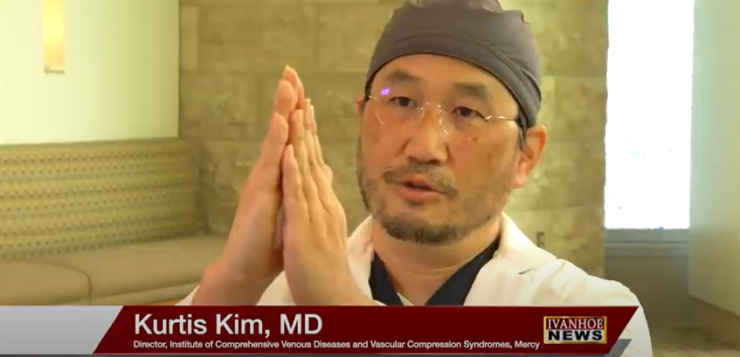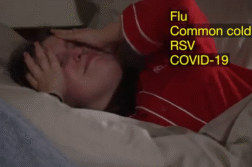Kurtis Kim, MD, Director of Institute of Comprehensive Venous Diseases and Vascular Compression Syndromes, Mercy, talks about procedures medical specialists are using to bring patents with nutcracker syndome relief.
Can you tell me what Nutcracker syndrome is exactly?
KIM: Nutcracker syndrome is a syndrome that involves blood vessels, especially the veins. There are several vascular compression diseases in the body. In our institution as we see a fair number of these patients, we’ve named this abdominal vascular compression syndrome AVCS to describe about four different compressions that can happen. There’s a median arcuate ligament syndrome where the celiac artery gets compressed, Nutcracker syndrome where the left renal vein gets compressed, SMA syndrome where the superior mesenteric artery compresses on the small bowel, and then May-Thurner syndrome, which compresses the left iliac vein most commonly, although it could happen in both legs.
And, why the name Nutcracker syndrome?
KIM: If you can imagine a walnut cracker, it has a hinge, and as you squeeze the handles together, it crunches and breaks the walnut. With Nutcracker syndrome, it’s the main aorta, which is the largest artery in our body that comes down to the abdomen. There are multiple branches that supply different parts of our body, but down in the abdomen there is an artery called superior mesenteric artery which comes off of the aorta. In between, there is a renal vein that comes to the left side and then small bowel, that passes in between. Some people have a very sharp angle almost parallel to the aorta. We call it a narrow aortic mesenteric angle. You could imagine the Nutcracker being cracked like this where the renal vein gets really compressed and that is where the small bowel, called duodenum, gets compressed along with it. That’s how the name Nutcracker syndrome came from.
What’s happening to patients when they have this syndrome, and those areas are being compressed?
KIM: In the textbooks and what we know, it is described as left flank pain. Kind of like kidney stone pain. Then the hematuria, or the blood in urine, for some people can lead to a pelvic congestion pain. Definition of syndromes usually evolve over time. In our experience, that’s what we’ve been trying to advocate for because there’s a lot more that’s involved than just the boxes where we check off flank pain, pelvic pain, and hematuria. In our gathering of the data and presentations of these, we found there’s a vast number of symptoms a patient can present with. Certainly, the flank pain and then hematuria and then the pelvic congestion are very well connected with Nutcracker, but a lot of patients also present with GI issues like paralysis of their stomach, they can’t eat, or they’re unable to digest their food. Therefore, they become very cachectic and can’t gain weight or maintain their weight to the point where sometimes it’s not compatible with life. So, as specialized as we are, they get to see different doctors to kind of go through their issues. Another symptom is back pain. With back pain, we usually think about spine issues, but these patients usually have a perfectly good spine and they’re usually young. I’ve seen as early as a 14-year-old up to 70, but usually in their 20’s and 30’s is when they really have these issues. There are many more and we are in the process of connecting the dots.
How does that play into getting the diagnosis? Does it make it more difficult to diagnose?
KIM: Absolutely. I think that’s one of the reasons why Nutcracker syndrome gets a diagnosis very late or gets misdiagnosed with different things. For example, there are patients who come to me with what’s called cystitis, or inflammation of the bladder. They don’t know exactly why the patient’s having inflammation, but it’s related to Nutcracker syndrome where the venous congestion down in the urinary system congests the bladder and creates inflammation. Some of these patients have frequent UTI’s or UTI like symptoms, pain, or burning. They are looked at by a urologist and in that perspective it’s normal, yet they continue with these pains or infections that are linked to Nutcracker syndrome. Stomach pain is seen by gastroenterologists but usually work up doesn’t show any abnormalities.
Do we know what causes the congestion? Is it genetic?
KIM: It is not clear yet. There are patients who have what’s called Ehlers-Danlos syndrome. Those are connective tissue disorders that can affect different parts of the body system, including bones and ligaments. Then, there are people who have a vascular type of Ehlers-Danlos syndrome, and some have other aspects of it, but they’re not the only group that gets Nutcracker syndrome. In my experience of seeing them, they’re the minority. There are a lot of other people who have no Ehlers-Danlos but have Nutcracker syndrome.
So, it’s hard to tell what might cause it?
KIM: Right. I think at some point we will get to genetic testing where we can say this is what you could potentially develop on these compressions. At this point in our experience here at Mercy, we see all four compressions happening at once in a single patient. So, it’s not uncommon for me to see a patient who may have median arcuate ligament syndrome for which they had surgery but did not get better and they’re looking for other answers. Not all the symptoms get better. They may get treated for one compression and the other one does not get better, or the other one gets really worse and flares up.
Do the patient go for a while without a diagnosis? What is the danger or some of the things that could happen?
KIM: Renal failure is something that we don’t know yet. It certainly affects the kidney function in my mind, especially in the younger group of people who are losing blood through their urinary system. Long term effects of it haven’t been studied yet. Certainly, you can imagine the GI symptoms where they continue to lose weight or go on feeding tubes. Still, feeding tubes are not very effective because the compression is affecting the GI system, so they end up getting IV nutrition. At some point, that’s not compatible with life when you have lost so much weight.
What are the treatments for Nutcracker syndrome?
KIM: There are several treatments, but none are 100% successful. The most recent, endovascular stenting has been investigated and in my experience is not ideal. Less than 50% of my patients that I initially treated with endovascular stenting did well, and then we had to convert it to another surgery. So, there is still a lot of research that needs to be done. There is also extravascular stenting, which is the stent or graft that goes outside of the vein. Which leads to the vein being lifted so that it’s not under compression anymore. That’s being done in few places, including here at Mercy. The other option is a little bit more invasive. We talked about the Nutcracker where the renal vein is at the crotch. What we do is divide the vein and move it down about three to five centimeters so that there is less of a compression and the kidney below can flow out easily. Another option is auto-transplant. It’s like a transplant, but you’re taking the kidney from the left side and putting it down into the pelvis. That surgery evolved over time for urologic patients who had chronic kidney stones and developed a lot of pain that’s chronic even without stones. Auto-transplant has worked out nicely for them and I think is currently a good option, but I would like to see that number go down. There is a risk of kidney loss and other complications that comes with a putting a kidney down in the pelvis. So, there is a lot of work that needs to be done, and hopefully we’ll come up with a plan where patients can be treated with simple surgeries that could really help them out. One of the most important things is all these compression syndromes are somehow connected clinically. We don’t know exactly physiologically how they are connected, but it’s good to look at the whole picture first before surgery to have some sequence and plan of treating these compression syndromes.
Tell us a little bit about Christine?
KIM: Christine was in one of my first group of patients with Nutcracker syndrome. I’ve evolved to get into this field because I worked on May-Thurner syndrome for a very long time, and we published a large patient data paper on it. Some of those patients who had May-Thurner syndrome did have Nutcracker syndrome, and that’s how it led me to research it. Nutcracker patients also can have median arcuate ligament syndrome, and that’s how we evolved to call this an abdominal vascular compression syndrome. Christine essentially had May-Thurner syndrome, for which we placed a stent. May-Thurner syndrome and stents work nicely, usually, but her symptoms did not resolve. She had pelvic congestion along with it. Then we found she had Nutcracker syndrome as well. We did a Nutcracker surgery on her, and she is much better than before, but still going through residual issues. We’re suspecting she may have median arcuate ligament syndrome as well. So, we’re working with different doctors to track down and see what she has at this point.
Could you describe Christine’s surgery?
KIM: In Christine’s case, when patients have symptoms that correlate with ultrasound or CT scans or other imaging studies that matches the disease, the next step is more invasive testing, called a venogram. It’s usually done through a small needle stick on the neck or in the leg. We go in and take pictures of the vein from inside to see how the blood flows. Then, we take a very small ultrasound called intravascular ultrasound. It’s a tiny ultrasound that gets mounted onto a wire,that goes inside of the vein and we start taking pictures. It’s kind of like an endoscopy or colonoscopy for your vein. When we go in there, we’re able to accurately measure where the compressions are, what degree of compression is, and get to a percentage point that helps us make the diagnosis of how much they’re compressed. Because our venous system, or arterial system, are connected like our highway system, once we get into one vein, we’re able to go into the renal vein and then the internal iliac veins and femoral veins and take pictures to get a fine level of accuracy in diagnosing. But final diagnosis of these is not just one test. It’s multiple boxes that need to be checked off and not everybody is going to check off all the boxes. I think that’s what makes the diagnosis difficult.
What were you able to do to help Christine?
KIM: For Christine, we ended up stenting her left renal vein and that opened the compression which relieved a lot of her pain. We did go back to address her pelvic congestion more by coiling her ovarian veins. After about a month or two, that stent is very adhered into the vein at that point. So, it becomes part of the vein structure that gives radial force to lift whatever was compressing it. In Nutcracker, it’s the superior mesenteric artery, so it stays there and it’s a part of her body. Technical success on these is very good. Most people at this point in endovascular therapy can do this procedure and technical success rate is very high. But does it solve the patient’s problem? I think in some people it does and in some people it doesn’t. Our role moving forward will be to see which one’s going to be helped with endovascular stenting which is more minimally invasive and has easier recovery, versus who’s going to need major surgeries. Being able to cherry pick them will be a big advancement for the patients so that we don’t get to guess at things at this point.
So, the stent placed in the left renal vein is considered a minimally invasive procedure?
KIM: Correct. It’s the same needle that goes through the internal jugular vein on the right. Through the needle hole we’re able to do everything. We move the needle and there’s a little hole that seals over time on their own with a dressing. Time for something like that is less than an hour and the patient recovers nicely.
Does vascular compression syndrome, in any way, affect fertility?
KIM: It certainly has a link with male infertility. Males with Nutcracker syndrome present with a varicocele in their testes that has been linked to infertility. For females, we are not so sure yet. There is case reports and case series, not many studies, that shows it does not affect fertility, but we don’t have long-term data to demonstrate that. I would imagine that it does affect fertility in some ways as it does for the male.
How does Christine look to you now?
KIM: She’s doing very well. These are a group of patients that are very tough. They’ve been seeking answers for as short as six months to 20 years. They’re able to, during that time, have children and have careers. However, some of my patients stay in their bed all day. Other things that I didn’t mention is other cardiovascular symptoms of Nutcracker syndrome. They chronically have low blood pressure and sometimes a very high heart rate. When they stand up quickly or stand up for more than five minutes, they faint. It’s called POTS syndrome which stands for postural orthostatic tachycardia syndrome. In severe cases, they need medications and IV fluids weekly or three times a week or even daily to function. The disability related to Nutcracker syndrome varies, but in the severe cases it is a life-changing experience if they come to a right diagnosis and get to surgery. For Christine, she really came a long way. I am grateful to her for allowing me to work with her. We treated her May-Thurner syndrome and the Nutcracker syndrome and some of the pelvic congestion. She’s in a much better place than where she was. So, I’m pleased to meet her every so often to check her stents, make sure they are good, open and functioning very well. The better news is that she seems to have her life back, and that’s the most joy we get to have after treating the disease.
Did she have any restrictions?
KIM: No. She’s still going through some muscular pain issues and working with different specialty doctors for that. Whether that’s related to vascular issues or not, we’re still looking to find out more. However, she’s pretty active at this point and living a life that she lost for many years.
Is there anything you would like to add to make sure people know?
KIM: Yes, I wanted to go into more detail about the symptoms of Nutcracker syndrome. The symptoms we talked about initially, are the typical ones. Then, there are GI related and cardiovascular related symptoms. Some people have chronic headaches and/or migraines. We’re not sure whether that’s clearly related, but we see some patients after Nutcracker treatment have their migraines and headaches disappear. POTS syndrome disappears as well with some patients we treat. There is an immediate change in their pulse rate, their blood pressure rises, and they have more energy. Chronic constipation is related to either Nutcracker or May-Thurner syndrome. Some people are diagnosed with irritable bowel syndrome because there’s not really a specific diagnosis they could make but have bowel issues. These things often do go away after treatment. There is so much havoc that venous disease can create in the body that we are getting to know, and this is how Nutcracker syndrome evolved. May-Thurner syndrome also presents with multi systemic symptoms. The interesting thing is arterial disease has a very one to one sort of relationship with pain and the result. So, if you have artery disease in one area, you have very specific symptoms. If you fix that, we expect the symptoms to go away. Veins, because they have so much ability to create different networks and connect to different body networks of veins in the entire body, fixing one of them doesn’t quite work out very well. The symptom of narrowing of the vein and the renal vein, which is Nutcracker syndrome, creates all these other symptoms not just related to the kidney, but in the pelvis, the GI, neurologic, and back pain. So, that’s where there are interesting points that need to be investigated. At the same time, it becomes a very difficult diagnosis because they end up seeing specialists for each one of symptoms.
Interview conducted by Ivanhoe Broadcast News.
END OF INTERVIEW
This information is intended for additional research purposes only. It is not to be used as a prescription or advice from Ivanhoe Broadcast News, Inc. or any medical professional interviewed. Ivanhoe Broadcast News, Inc. assumes no responsibility for the depth or accuracy of physician statements. Procedures or medicines apply to different people and medical factors; always consult your physician on medical matters.
If you would like more information, please contact:
DAN COLLINS
410-332-9714
Sign up for a free weekly e-mail on Medical Breakthroughs called First to Know by clicking here




